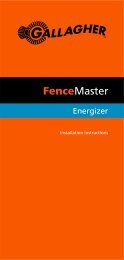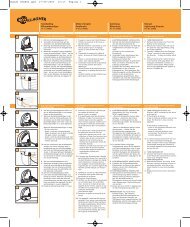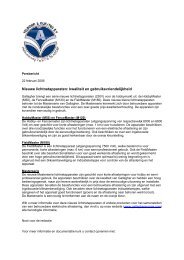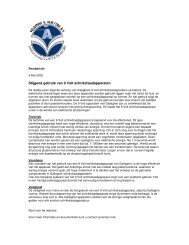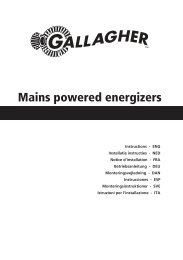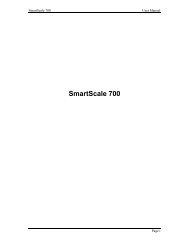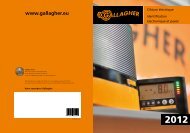Battery powered energizer installation instructions - Gallagher.eu
Battery powered energizer installation instructions - Gallagher.eu
Battery powered energizer installation instructions - Gallagher.eu
Create successful ePaper yourself
Turn your PDF publications into a flip-book with our unique Google optimized e-Paper software.
English<br />
6<br />
•<br />
•<br />
•<br />
•<br />
•<br />
•<br />
•<br />
•<br />
•<br />
•<br />
•<br />
•<br />
•<br />
•<br />
Barbed wire or razor wire shall not be electrified by an <strong>energizer</strong>.<br />
A non-electrified fence incorporating barbed wire or razor wire may be used<br />
to support one or more off-set electrified wires of an electric animal fence. The<br />
supporting devices for the electrified wires shall be constructed so as to ensure<br />
that these wires are positioned at a minimum distance of 150mm from the<br />
vertical plane of the non-electrified wires. The barbed wire and razor wire shall<br />
be earthed at regular intervals.<br />
Follow the <strong>energizer</strong> manufacturer’s recommendations regarding earthing.<br />
Do not install an earth (ground) system for your electric fence within 10m ( ft)<br />
of any power, telecommunications or other system.<br />
Except for low output battery operated <strong>energizer</strong>s, the <strong>energizer</strong> earth<br />
electrode should penetrate the ground to a depth of at least 1m ( ft).<br />
Use high voltage lead-out cable in buildings to effectively insulate from the<br />
earthed structural parts of the building and where soil could corrode exposed<br />
galvanised wire. Do not use household electrical cable.<br />
Connecting leads that are run underground shall be run in conduit of<br />
insulating material or else insulated high voltage lead-out cable shall be used.<br />
Care must be taken to avoid damage to the connecting leads due to the effects<br />
of animal hooves or tractor wheels sinking into the ground.<br />
Connecting leads shall not be installed in the same conduit as the mains supply<br />
wiring, communication cables or data cables.<br />
Connecting leads and electric animal fence wires shall not cross above<br />
overhead power or communication lines.<br />
Crossings with overhead power lines shall be avoided wherever possible. If such<br />
a crossing cannot be avoided it shall be made underneath the power line and<br />
as nearly as possible at right angles to it.<br />
If connecting leads and electric animal fence wires are installed near an<br />
overhead power line, the clearances shall not be less than those shown in the<br />
table below.<br />
Minimum clearances from power lines for electric animal fences<br />
Less than or equal to 1 000<br />
Power line Voltage V Clearance m<br />
Greater than 1 000 and less than or equal to 000 4<br />
Greater than 000 8<br />
If connecting leads and electric animal fence wires are installed near an<br />
overhead power line, their height above the ground shall not exceed m<br />
This height applies either side of the orthogonal projection of the outermost<br />
conductors of the power line on the ground surface, for a distance of<br />
• m for power lines operating at a nominal voltage not exceeding 1 000V;<br />
• 15m for power lines operating at a nominal voltage exceeding 1 000V.<br />
Electric animal fences intended for deterring birds, household pet containment<br />
or training animals such as cows need only be supplied from low output<br />
<strong>energizer</strong>s to obtain satisfactory and safe performance.<br />
In electric animal fences intended for deterring birds from roosting on<br />
buildings, no electric fence wire shall be connected to the <strong>energizer</strong> earth<br />
electrode. A warning sign (G60 0) shall be fitted to every point where persons<br />
may gain ready access to the conductors.



